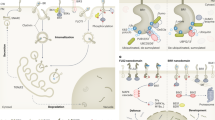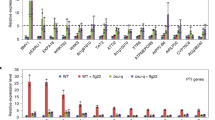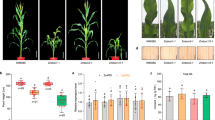Abstract
Brassinosteroids (BRs) are a major group of plant hormones that regulate plant growth and development. BRI1, a protein localized to the plasma membrane, functions as a BR receptor and it has been proposed that its kinase activity has an essential role in BR-regulated plant growth and development. Here we report the isolation and molecular characterization of a new allele of bri1, bri1–301, which shows moderate morphological phenotypes and a reduced response to BRs under normal growth conditions. Sequence analysis identified a two-base alteration from GG to AT, resulting in a conversion of 989G to 989I in the BRI1 kinase domain. An in vitro assay of kinase activity showed that bri1-301 has no detectable autophosphorylation activity or phosphorylation activity towards the BRI1 substrates TTL and BAK1. Furthermore, our results suggest that bri1-301, even with extremely impaired kinase activity, still retains partial function in regulating plant growth and development, which raises the question of whether BRI1 kinase activity is essential for BR-mediated growth and development in higher plants.
Similar content being viewed by others
Log in or create a free account to read this content
Gain free access to this article, as well as selected content from this journal and more on nature.com
or
References
Clouse SD, Langford M, McMorris TC . A brassinosteroid-insensitive mutant in Arabidopsis thaliana exhibits multiple defects in growth and development. Plant Physiol 1996; 111:671–678.
Clouse SD, Sasse JM . Brassinosteroids: essential regulators of plant growth and development. Annu Rev Plant Physiol Plant Mol Biol 1998; 49:427–451.
Mangelsdorf DJ, Thummel C, Beato M, et al. The nuclear receptor superfamily: the second decade. Cell 1995; 83:835–839.
He Z, Wang ZY, Li J, et al. Perception of brassinosteroids by the extracellular domain of the receptor kinase BRI1. Science 2000; 288:2360–2363.
Kinoshita T, Cano-Delgado A, Seto H, et al. Binding of brassinosteroids to the extracellular domain of plant receptor kinase BRI1. Nature 2005; 433:167–171.
Li J, Chory J . A putative leucine-rich repeat receptor kinase involved in brassinosteroid signal transduction. Cell 1997; 90:929–938.
Wang ZY, Seto H, Fujioka S, Yoshida S, Chory J . BRI1 is a critical component of a plasma-membrane receptor for plant steroids. Nature 2001; 410:380–383.
Chono M, Honda I, Zeniya H, et al. A semidwarf phenotype of barley uzu results from a nucleotide substitution in the gene encoding a putative brassinosteroid receptor. Plant Physiol 2003; 133:1209–1219.
Montoya T, Nomura T, Farrar K, Kaneta T, Yokota T, Bishop GJ . Cloning the tomato curl3 gene highlights the putative dual role of the leucine-rich repeat receptor kinase tBRI1/SR160 in plant steroid hormone and peptide hormone signaling. Plant Cell 2002; 14:3163–3176.
Nomura T, Bishop GJ, Kaneta T, Reid JB, Chory J, Yokota T . The LKA gene is a BRASSINOSTEROID INSENSITIVE 1 homolog of pea. Plant J 2003; 36:291–300.
Sun Y, Fokar M, Asami T, Yoshida S, Allen RD . Characterization of the brassinosteroid insensitive 1 genes of cotton. Plant Mol Biol 2004; 54:221–232.
Yamamuro C, Ihara Y, Wu X, et al. Loss of function of a rice brassinosteroid insensitive1 homolog prevents internode elongation and bending of the lamina joint. Plant Cell 2000; 12:1591–1606.
Friedrichsen DM, Joazeiro CA, Li J, Hunter T, Chory J . Brassinosteroid-insensitive-1 is a ubiquitously expressed leucine-rich repeat receptor Serine/Threonine kinase. Plant Physiol 2000; 123:1247–1256.
Nam KH, Li J . BRI1/BAK1, a receptor kinase pair mediating brassinosteroid signaling. Cell 2002; 110:203–212.
Li J, Wen J, Lease KA, Doke JT, Tax FE, Walker JC . BAK1, an Arabidopsis LRR receptor-like protein kinase, interacts with BRI1 and modulates brassinosteroid signaling. Cell 2002; 110:213–222.
Russinova E, Borst JW, Kwaaitaal M, et al. Heterodimerization and endocytosis of Arabidopsis brassinosteroid receptors BRI1 and AtSERK3 (BAK1). Plant Cell 2004; 16:3216–3229.
Wang X, Goshe MB, Soderblom EJ, et al. Identification and functional analysis of in vivo phosphorylation sites of the Arabidopsis BRASSINOSTEROID-INSENSITIVE1 receptor kinase. Plant Cell 2005; 17:1685–1703.
Nam KH, Li J . The Arabidopsis transthyretin-like protein is a potential substrate of BRASSINOSTEROID-INSENSITIVE 1. Plant Cell 2004; 16:2406–2417.
Wang X, Chory J . Brassinosteroids regulate dissociation of BKI1, a negative regulator of BRI1 signaling, from the plasma membrane. Science 2006; 313:1118–1122.
Kim TW, Lee SM, Joo SH, et al. Elongation and gravitropic responses of Arabidopsis roots are regulated by brassinolide and IAA. Plant Cell Environ 2007; 30:679–689.
Cano-Delgado A, Yin Y, Yu C, et al. BRL1 and BRL3 are novel brassinosteroid receptors that function in vascular differentiation in Arabidopsis. Development 2004; 131:5341–5351.
Zhao J, Peng P, Schmitz RJ, Decker AD, Tax FE, Li J . Two putative BIN2 substrates are nuclear components of brassinosteroid signaling. Plant Physiol 2002; 130:1221–1229.
Goda H, Shimada Y, Asami T, Fujioka S, Yoshida S . Microarray analysis of brassinosteroid-regulated genes in Arabidopsis. Plant Physiol 2002; 130:1319–1334.
Kenigsbuch D, Tobin EM . A region of the Arabidopis Lhcb1*3 promoter that binds to CA-1 activity is essential for high expression and phytochrome regulation. Plant Physiol 1995; 108:1023–1027.
Dedonder A, Rethy R, Fredericq H, Van Montagu M, Krebbers E . Arabidopsis rbcS genes are differentially regulated by light. Plant Physiol 1993; 101:801–808.
Turk EM, Fujioka S, Seto H, et al. CYP72B1 inactivates brassinosteroid hormones: an intersection between photomorphogenesis and plant steroid signal transduction. Plant Physiol 2003; 133:1643–1653.
Mathur J, Molnar G, Fujioka S, et al. Transcription of the Arabidopsis CPD gene, encoding a steroidogenic cytochrome P450, is negatively controlled by brassinosteroids. Plant J 1998; 14:593–602.
Vert G, Nemhauser JL, Geldner N, Hong F, Chory J . Molecular mechanisms of steroid hormone signaling in plants. Annu Rev Cell Dev Biol 2005; 21:177–201.
Noguchi T, Fujioka S, Choe S, et al. Brassinosteroid-insensitive dwarf mutants of Arabidopsis accumulate brassinosteroids. Plant Physiol 1999; 121:743–752.
Fankhauser C, Chory J . Light control of plant development. Annu Rev Cell Dev Biol 1997; 13:203–229.
Chory J . Light modulation of vegetative development. Plant Cell 1997; 9:1225–1234.
Nemhauser JL, Maloof JN, Chory J . Building integrated models of plant growth and development. Plant Physiol 2003; 132:436–439.
Kang JG, Yun J, Kim DH, et al. Light and brassinosteroid signals are integrated via a dark-induced small G protein in etiolated seedling growth. Cell 2001; 105:625–636.
Neff MM, Nguyen SM, Malancharuvil EJ, et al. BAS1: A gene regulating brassinosteroid levels and light responsiveness in Arabidopsis. Proc Natl Acad Sci USA 1999; 96:15316–15323.
Li J, Nagpal P, Vitart V, McMorris TC, Chory J . A role for brassinosteroids in light-dependent development of Arabidopsis. Science 1996; 272:398–401.
Gamborg OL, Miller RA, Ojima K . Nutrient requirements of suspension cultures of soybean root cells. Exp Cell Res 1968; 50:151–158.
Mou Z, He Y, Dai Y, Liu X, Li J . Deficiency in fatty acid synthase leads to premature cell death and dramatic alterations in plant morphology. Plant Cell 2000; 12:405–418.
Murashige T, Skoog F . A revised medium for rapid growth and bioassays with tobacco tissue culture. Physiol Plant 1962; 15:473–497.
Jacobs M, Dolferus R, Van den Bossche D . Isolation and biochemical analysis of ethyl methanesulfonate-induced alcohol dehydrogenase null mutants of Arabidopsis thaliana (L.) Heynh. Biochem Genet 1988; 26:105–122.
Li J, Zhao J, Rose AB, Schmidt R, Last RL . Arabidopsis phosphoribosylanthranilate isomerase: molecular genetic analysis of triplicate tryptophan pathway genes. Plant Cell 1995; 7:447–461.
Bell CJ, Ecker JR . Assignment of 30 microsatellite loci to the linkage map of Arabidopsis. Genomics 1994; 19:137–144.
Konieczny A, Ausubel FM . A procedure for mapping Arabidopsis mutations using co-dominant ecotype-specific PCR-based markers. Plant J 1993; 4:403–410.
Hu Y, Bao F, Li J . Promotive effect of brassinosteroids on cell division involves a distinct CycD3-induction pathway in Arabidopsis. Plant J 2000; 24:693–701.
Acknowledgements
We thank Prof Joanne Chory (The Salk Institute for Biological Studies, USA) for providing the Arabidopsis bri1-101 mutant seeds. This work was supported by grants from the National Natural Science Foundation of China (grant numbers: 30070074, 30330040 and 30570161).
Author information
Authors and Affiliations
Corresponding author
Rights and permissions
About this article
Cite this article
Xu, W., Huang, J., Li, B. et al. Is kinase activity essential for biological functions of BRI1?. Cell Res 18, 472–478 (2008). https://doi.org/10.1038/cr.2008.36
Received:
Revised:
Accepted:
Published:
Issue date:
DOI: https://doi.org/10.1038/cr.2008.36
Keywords
This article is cited by
-
Unraveling the Dynamic Integration of Auxin, Brassinosteroid and Gibberellin in Early Shade-Induced Hypocotyl Elongation
Phenomics (2022)
-
A microbiota–root–shoot circuit favours Arabidopsis growth over defence under suboptimal light
Nature Plants (2021)
-
Integrated omics networks reveal the temporal signaling events of brassinosteroid response in Arabidopsis
Nature Communications (2021)
-
Identification of novel QTLs for grain fertility and associated traits to decipher poor grain filling of basal spikelets in dense panicle rice
Scientific Reports (2021)
-
A novel single-base mutation in CaBRI1 confers dwarf phenotype and brassinosteroid accumulation in pepper
Molecular Genetics and Genomics (2020)



